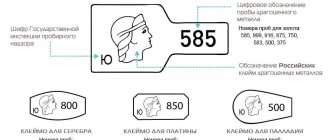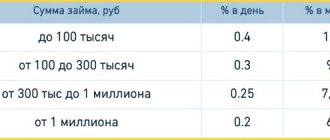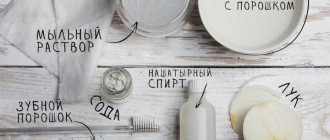Why do you need a sample on jewelry?
Such a concept as “sample” appeared in jewelry when the need to control the consumption of precious metals and their content in various alloys was recognized.
The mark determined the proportion of precious metal in the alloy from which a particular product was made. It is impossible to obtain strong and durable jewelry that is resistant to deformation from pure precious metal, so jewelry and other items are made from alloys. A precious metal alloy may include zinc, copper, silver, nickel and other metals that are responsible for certain properties and characteristics, including the color of the product. Metals added to an alloy are called alloys. Knowing what types of precious alloys there are, you can easily determine the quality of a particular piece of jewelry.
The situation in the Russian jewelry industry.
The jewelry industry in Russia remains one of the most conservative and closed. At the moment, the country already has a state system of control over the circulation of precious metals and precious stones. As part of this system, jewelry made from precious metals is branded and tested.
But existing regulatory methods have not changed for quite a long time and no longer meet the main task.
According to Deputy Minister Alexei Moiseev, the need to strengthen state control over the circulation of precious metals and stones is associated with “high risks of money laundering.”
At the same time, the distrust of ordinary consumers towards the jewelry industry is growing .
The Integrated Information System in the field of control over the circulation of precious metals and precious stones at all stages of their circulation (hereinafter referred to as GIIS DMDK) is designed to solve all the accumulated problems
What is an integrated information system?
GIIS DMDK involves marking jewelry at the final stage by printing a two-dimensional code on the jewelry tag.
From June to November 2021, an experiment was conducted on labeling certain types of precious metals, precious stones and products made from them. The experiment was considered successful .
The operator and developer of the information GIIS DMDK is JSC Goznak.
Based on the results of consideration of the results of the experiment, the Government of the Russian Federation instructed the Ministry of Finance of Russia to ensure the completion of the integrated information system.
What products are tested?
The state hallmark is placed on all products made of precious metals and their alloys using artistic processing, with inserts of precious, jewelry, ornamental and colored stones. In addition, the sample is minted for commemorative, anniversary signs and medals, except for commemorative coins that have been issued, as well as state awards.
Each precious metal on which the alloy is made has not only a certain set of digital hallmarks, but also the shape of a mark. In this case, gold-plated silver jewelry is branded as silver.
The following products are not stamped:
- Nuggets of precious metals used as jewelry (inserts, onlays, pendants, etc.), for such products a certificate for nuggets of precious metals is sufficient.
- Gold and silver leaf, as well as small incisions in gold and silver on weapons, vases, dishes, caskets and religious objects.
If a piece of jewelry is imported from abroad for sale, it may be of a lower standard than that established in accordance with Russian standards for the alloy of a particular precious metal. In such cases, the State Assay Inspectorate stamps the product according to the nearest lower established standard. If the content of precious metal in an imported product does not correspond to even the lowest standard established by the state, the stamp is not applied.
Identification methods
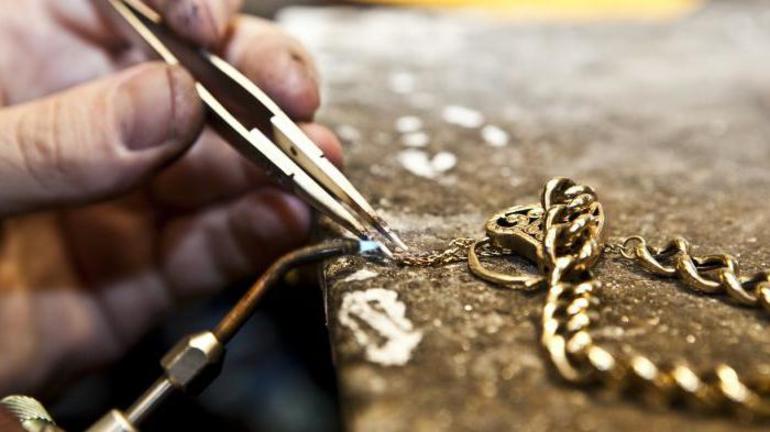
The oldest and most common branding method is mechanical. In this case, the impression on the product is made manually - a special tool is placed on the surface of the metal, which is struck with a hammer. Later, a similar operation began to be carried out using a machine. The mark comes out clear and lasts for a long time. However, with this method the product may become deformed.
With the development of jewelry technologies, spark and laser methods began to find widespread use. Such methods require more thorough preparation of the metal.
The mark on gold products, made using a laser, is of high quality and can be applied to any relief. The disadvantages include instability - with daily contact of the brand with the surface of the skin, its lifespan does not exceed 5 years.
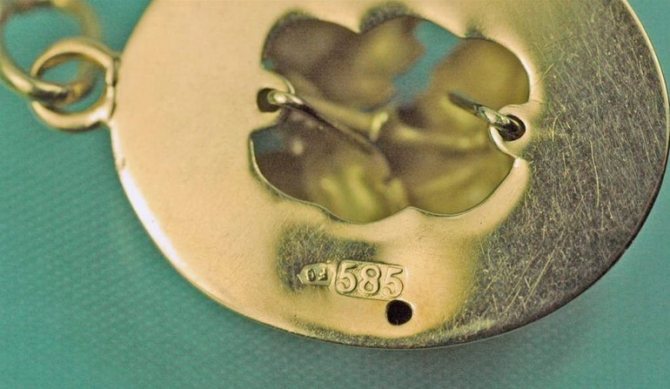
The assay office is responsible for setting samples on jewelry. This applies to both private workshops and large jewelry enterprises. An individual can also contact this institution to test a piece of jewelry. For this purpose, the offices have special reception days. The procedure is carried out within several working days.
How is jewelry assayed?
All samples of precious metal alloys are strictly regulated and controlled by the state. That is why every piece of jewelry must undergo control by the State Trial Supervision Inspectorate. After inspection, if the product meets the stated requirements, it is stamped with numbers indicating the sample. If a product does not have an assay mark, its quality raises fair doubts.
The state hallmark is placed using an electric spark or laser method by state assay supervision inspectorates.
Location and appearance
Where jewelry is marked depends on the type of jewelry. But regardless of the location of the sign, manufacturers try to make it inconspicuous. To find it, it is better to use a lens. Most often the mark is located in the following places:
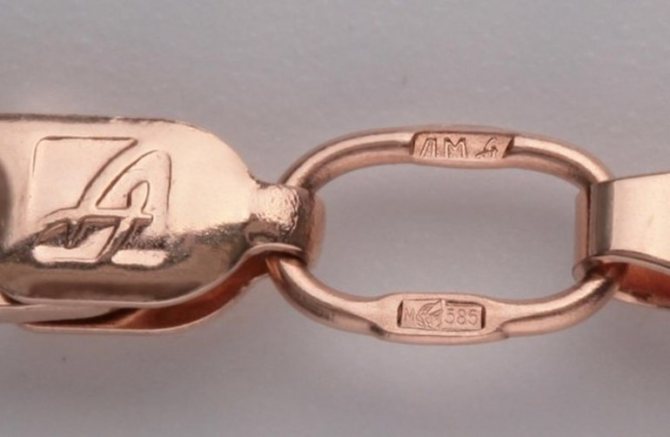
- On a ring - inside or outside the rim.
- On earrings - on earrings or pins.
- On pendants or pendants - on special rings for hanging.
- On the bracelet - between the product and the lock.
The mark that is issued by the controlling body - the state assay office - consists of 2 contours of a rectangular, oval or oblong shape (for gold). Inside you can see the profile of a girl in a kokoshnik facing to the right, the inspection code and numbers indicating the sample. If we are talking about items made in the USSR, the gold hallmark looks like a five-pointed star.
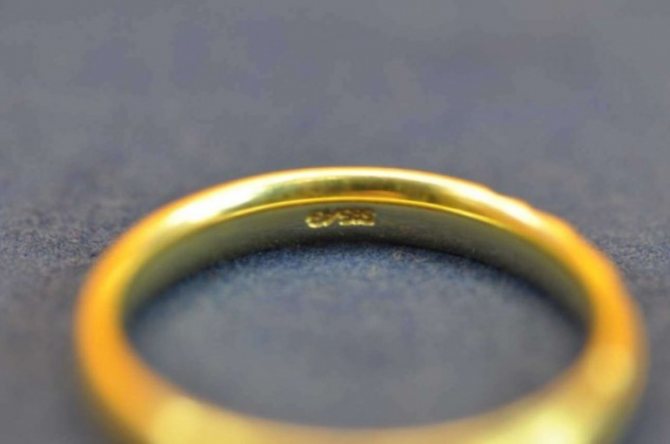
For other precious metals, signs in the form of other figures are provided. The code shows which territorial inspection carried out the inspection and stamped the jewelry. For each division there is a strict arrangement of elements. For example, the Central Inspectorate (CIPN) marks gold products with the letter M in the lower left corner of the hallmark or a dot in its upper right corner.
What are the types of precious metals?
Today, two systems for testing products made from precious metal alloys are the most widely used. The karat system, which has German roots, is used abroad for gold alloys. The pure gold content is determined by the number of carats (1 carat equals 9.7 g) in one “Cologne mark” (233.8 g). Pure gold will be 24 karat. A sample of 18 carats will mean that the alloy contains 18 carats of pure gold and 6 carats of ligature. There are alloys of 9,14, 18 and 22 carats. This system has nothing in common with the system for measuring the mass of precious stones.
In Russia, the metric testing system has been used since 1927. It is much easier to understand: the number on the sample means the number of grams of pure precious metal in one kilogram of alloy.
Currently, GOST R 53197-2008 is in force, according to which the following tests are used in Russia:
- Gold: 375, 500, 585, 750, 958, 999 and 999.9.
- Silver: 800, 830, 875, 925, 960, 999.
- Platinum:
850, 900, 950, 990. - Palladium:
500, 850, 900, 950, 990.
Platinum samples
" Platinum " is a Spanish word translated as "silver". The name reflects the disdainful attitude towards the metal at the dawn of its discovery. At that time, platinum was considered a useless additive to gold ore.
Externally, the element looks like silver, also white. Hence the name. However, the hallmarks of platinum are different from those of silver. They do not match the gold ones either. We'll tell you what the differences are below.
Platinum samples
Assays on all precious items indicate their base metal content. The scheme is the same for gold, and for silver, titanium, palladium and, of course, platinum. However, if for gold the 585th marking with 58.5 percent solar element content is considered worthy, then for platinum the minimum level is 85%.
Sample, accordingly, is 850th. That is, alloying elements in the alloy are only 15%. Add copper. It gives plasticity. Cobalt is also added, which improves the mechanical properties of the alloy. There is an alloy made of iridium and tungsten. They increase the wear resistance of products.
If the alloy contains less than 85% platinum, it will not be suitable for jewelry. Even 850 proof leaves much to be desired. The luster of the metal is dull, the color is silver, and not dazzling white. Therefore, platinum, the purity of which is 850, is used mainly in industry.
If the product shows a number less than 850, then it is not platinum. 750 hallmark , for example, is minted on white gold. Outwardly, it looks like low-grade platinum. However, the composition either does not contain it at all, or the metal is used as a bleaching additive. This is what 750 sample means . Platinum is no more than 13% of the composition.
The 850th sample is followed by the 900th. It is also rarely used. The alloy no longer resembles rough silver, but the shine and color still leave much to be desired. Considering the high cost and prestige of platinum, there is almost no point in not adding 5% of valuable raw materials to jewelry.
As soon as its content is increased to 95%, the alloy begins to sparkle and sparkle. In addition, products of 950 standard are particularly durable.
Platinum hallmark 950 is the most common and dominates jewelry counters. If jewelry, watches, are imported from the West, a foreign marking is placed - 23.
The European system is called the carat system. Platinum marked “950” truly shines like a diamond. It is no secret that the mass of diamonds is calculated in carats.
This is where platinum jewelry samples . Metal marked "999" is essentially pure. There are no more than 0.45% impurities in it, which is an acceptable error.
Typically, platinum of 999 purity contains 99.9% of valuable raw materials. Such luxury is available only in bank bullion and special equipment for industry.
For example, some glassware for laboratories is made from platinum. The element is chemically inert. You can combine any reagents in precious flasks.
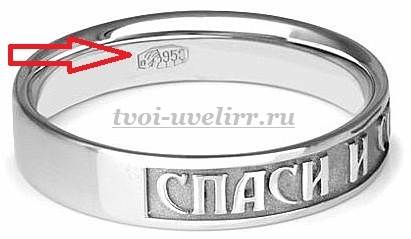
If the product is jewelry, the hallmarks of platinum and gold on it are tied to the nameplate. Why it is needed and what it is, we will tell you in the next chapter.
Is the name tag part of the sample or an optional element?
The sample is stamped at the Assay Supervision Chamber of the country. Products from various ]jewelers[/anchor] are supplied there. The organization checks the platinum content for compliance with the declared marking and, if everything is normal, imprints it on the metal.
The name plate is the work of a jeweler, either private or working in a large company. In the latter case, company data is reflected. They mean little to the buyer. Displayed: year of production, city and codes of the master, organization.
It seems that the platinum sample is more important. What kind of names there are is not so important. However, their very presence and correct location on the product is important. The name is printed to the left, or on top of the sample. The absence of a company mark indicates that the sample is fake.
This is the worst case scenario. At best, the jewelry corresponds to the markings, but was made underground, in a “shadow” workshop. In this case, you cannot boast about the origin of your acquisition.
Testing platinum on jewelry with a catch
Some imported samples are marked with both hallmark and nameplate. At the same time, the alloy does not correspond to the declared indicators. Sometimes you come across costume jewelry coated with a thin layer of platinum.
Laws allow labeling indicating the content of a valuable element in the spray. It is often gold or silver, but there are also products with platinum coating. What is underneath - only an examination will tell.
Russian hallmarks are not stamped on such goods, only carat ones. The price tag can be misleading. Imported jewelry sometimes costs no less than real platinum. So, you should be on your guard.
Another problem with imported goods is ligature. The platinum content is often true. But the rest of the cast is a mystery. There are products, for example, with a low melting point.
The reason for this can only be alloying elements. When worn normally, the jewelry is no worse than others. But, when handing over for repairs, difficulties may arise. An inexperienced jeweler will simply ruin the item.
As mentioned, carat marks are placed on imported products. The 950th corresponds, as it turned out, to the 23rd marking. Let's get acquainted with the carat indicators for other domestic hallmarks.
Carat hallmarks of platinum
Which sample corresponds to the Russian 850? Answer: - 20th. The 900th domestic mark is equivalent to 22 Western carats. About the 23rd hallmark, it is worth adding that it is special for Swiss platinum watches.
Since 1935, the Alpine stone goat has been imprinted on them. The mark resembles the astrological sign of Capricorn. The picture means nothing more than that the products correspond to 23 carats and 950 Russian standards.
The 999th hallmark of platinum corresponds to 24 carats. In the West, this is the only brand option. In Russia, there are several types of labeling. The most prestigious and valuable alloy is with 5-nines.
The mark 99.999 means that the product contains almost no impurities. Sometimes this is true, because the percentage of the ligature is the permissible maximum. It is regulated by federal standards and verified, as mentioned, by the country's Assay Office.
Samples of platinum from neighboring countries
Special markings are placed on jewelry from the Czech Republic and Slovakia. These countries have digital analogues of numerical indicators from Russia. So, the highest standard corresponds to “0”. The 950th stamp is replaced by one. Platinum of 900 standard is marked with a two. Three are reserved for the 850th marking.
An alloy with 80 percent platinum content is also produced in the Czech Republic and Slovakia. It is usually technical but, nevertheless, it takes place. The composition is marked with the number “4”.
How to read a hallmark on jewelry?
The mark consists of identification marks and hallmark marks, which can be affixed together (in a single outline) or separately.
Since 1958, the ID badge has been an image of a hammer and sickle against the background of a five-pointed star. Since 1994, the Russian Federation has had an identification sign representing the profile of a female head in a kokoshnik, turned to the right.
In addition to the stamp with a woman’s head and the hallmark designation, the product has another alphabetic code - the name tag. The first letter tells about the year of manufacture of the product. This value was introduced in 2001, and this year corresponded to the letter "A". Subsequent years were designated in alphabetical order. A product manufactured in 2015 will have a code starting with the letter “P”. Products manufactured before 2001 had numbers and signs in the code.
The second letter of the name indicates which specific Assay Supervision Inspectorate issued the stamp, depending on the area in which the production is located. For example, the Moscow Region State Assay Supervision Inspectorate in the city of Bronnitsy is designated by the letter “B”.
The next two characters in the nameplate are the manufacturer's code. The Assay Office recommends that manufacturers use no more than two letters of the Russian alphabet.
Brands of products of the Bronnitsky Jeweler brand
Products made of precious metals in the assortment of the Bronnitsky Jeweler franchise network have three degrees of protection, which can be used to verify their authenticity and quality.
- Personal hallmark of “Bronnitsky Jeweler”, registered by the Assay Supervision Inspectorate of the State Assay Chamber of the Ministry of Finance of the Russian Federation.
- The brand mark is updated every year and using it you can not only confirm the brand of the product, but also determine the year of manufacture of this product.
- Stamp of the Assay Supervision Inspectorate of the State Assay Chamber under the Ministry of Finance of the Russian Federation.
OTHER ARTICLES

